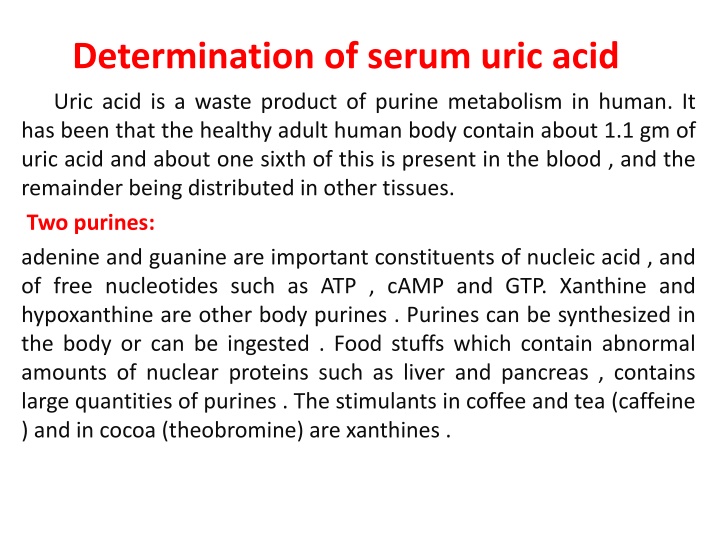
Understanding Serum Uric Acid and its Clinical Significance
Learn about serum uric acid, a waste product of purine metabolism in humans, its normal values, causes of elevated levels, associated disorders, symptoms of high or low acid levels, and treatment options. Explore how purines in foods can impact uric acid levels and discover the importance of monitoring uric acid for health maintenance.
Download Presentation

Please find below an Image/Link to download the presentation.
The content on the website is provided AS IS for your information and personal use only. It may not be sold, licensed, or shared on other websites without obtaining consent from the author. If you encounter any issues during the download, it is possible that the publisher has removed the file from their server.
You are allowed to download the files provided on this website for personal or commercial use, subject to the condition that they are used lawfully. All files are the property of their respective owners.
The content on the website is provided AS IS for your information and personal use only. It may not be sold, licensed, or shared on other websites without obtaining consent from the author.
E N D
Presentation Transcript
Determination of serum uric acid Uric acid is a waste product of purine metabolism in human. It has been that the healthy adult human body contain about 1.1 gm of uric acid and about one sixth of this is present in the blood , and the remainder being distributed in other tissues. Two purines: adenine and guanine are important constituents of nucleic acid , and of free nucleotides such as ATP , cAMP and GTP. Xanthine and hypoxanthine are other body purines . Purines can be synthesized in the body or can be ingested . Food stuffs which contain abnormal amounts of nuclear proteins such as liver and pancreas , contains large quantities of purines . The stimulants in coffee and tea (caffeine ) and in cocoa (theobromine) are xanthines .
Purine is present in a variety of protein foods, both animal and plant. When you eat large amounts of these purine foods, there is an increase in uric acid, which results in some health problems. Normal value of uric acid in the body *In males, the normal uric acid ranges from ( 3.4 - 7 mg / dL), * In females it ranges from (2.5 - 6 mg / dL).
Clinical Significance : There are 3 major causes for elevated level of uric acid : Gout, increased nuclear breakdown and renal diseases . 1. Gout is a diseases condition found primarily in males and usually fint diagnosed between the ages of 40-50 yr , patients have pain and inflammation of the joints owing to the high levels of u.a. found in extracellular fluids . 2. Increased breakdown of cell nuclei such as that which occur in patients on chemotherapy such as leukemia , lymphomas multiple myeloma 3. Chronic renal diseases. will also cause elevated levels of U.A.
In general hyperuricemia and hypouricemia are associated the with following clinical disorders 1 .Hyperuricemia;- - Acute and chronic Nephritis . - Urinary obstruction - Gout - Diabetic ketoacidosis - High purine diet - Leukemia - Acute infections - Elevate uric acid levels
Hypouricemia;- - Pernicious anemia - Acute atrophy of the liver Symptoms of high uric acid acid in the body 1.Swelling body limbs: whether fingers or toes, accompanied by swelling redness and pain. 2. High body temperature 3. Feeling tired 4. Nausea: This nausea may be accompanied by vomiting repeatedly and continuously. 5. Pain in the joints and muscles
Treatment of high uric acid acid in the body 1. Drink water in large quantities: not less than 2 liters per day because water helps in the kidneys function well, and thus rid of salts and the rise of this acid. 2. Avoid caffeine-containing beverages: coffee, tea or soft drinks. The caffeine compound causes dehydration and the difficulty of getting rid of the acid. 3. Eat diuretic foods 4. Reduce the intake of foods rich in purine: either animal proteins or plant proteins.






















